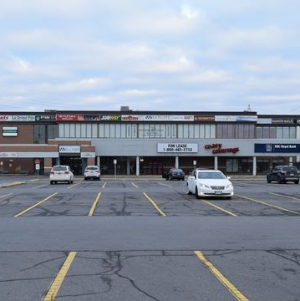Shopping Malls of all sizes are dying off in droves. It’s the delivery service phenomenon, and the massive move to direct ordering – personified by Amazon and eBay. What do we do with all the empty space? I humbly offer the following modest proposal…
 Westgate Shopping Mall. Ottawa’s first mall, opened 1955. Fond memories.
Westgate Shopping Mall. Ottawa’s first mall, opened 1955. Fond memories.
Huge former-department stores. Miles of walking corridors. So many abandoned shop spaces of a few hundred to a couple of thousand square feet each. All relics of an age that the hard necessities of running a business in the COVID Era rendered obsolete overnight.
What are cities, developers and community leaders suggesting be done with them?
The future is now
The problem is already way ahead of any possible solutions. One early effort to repurpose obsolete mega-retail spaces was centred on sideways redevelopment. Some former department stores and supermarkets were turned into offices and indoor recreational spaces. Gyms, rock climbing emporia and laser tag stadia. A few survive. But let’s face it. there are far more spaces than there recreational uses to fill them. And work-from-home has rendered many office space conversions moot.
Another direction in which some developers tried to take the dead malls (which they picked up for pennies on the dollar) was full tear-down-and-rebuild. Bull-doze them and imagine them into mixed use self-contained communities incorporating offices, service businesses condo style housing and public spaces.
The ‘Westgate Manoeuver’ didn’t work
One such project here in my home town, the redevelopment plan for Ottawa’s former Westgate Mall, (see photo, top of page) was doomed before it even got close to opening. The canary in the coal mine was a string of delays during approvals and construction. It looked like a great idea at first. Turn a big L-shaped ‘plaza’-style mall into one of these new, upscale urban business communities.
 The new Westgate: Not a retail store in sight…
The new Westgate: Not a retail store in sight…
The location was great: at the confluence of several main auto and bus roads, bordered by a couple of well-established small, clean industrial streets and surrounded for a mile or more on all sides with thousands of nice, middle-class single family and duplex-style homes. As a mall, which originated in the 1950s, it was a no-brain, sure-shot winner. But by the year 2010, it was an archeological oddity.
Even newer mega-Malls built later, in the 70s and 80s, were already echoing with the voices of history. You can almost hear septuagenarian tour guides saying, “When I was 20, this place was so jammed with shoppers on any given Saturday, you could hardly walk!”
My brilliant insight
Of course, yours truly has the ‘right’ answer to the mummified mall issue: Turn them into community small business hubs. Professional services, such as physio therapy, dentistry and medical offices – businesses you can’t trade with via the Internet – would be great all clumped together in one place. and the centrepiece of each such hub would be… (drum roll, please!) the community farmers’ market and street food mecca!
First and foremost, the availability of space with a roof over its head would be extemely attractive to market and street food vendors. Making grocery vendors and street food operations snug neighbours would be great for them. A natural symbiotic relationship, in fact. One-stop shopping, walking, and meeting-and greeting-activities would ensure the place benefitted from safety-in-numbers social dynamics. Dining ‘pods’ such s those offered by all the old-school Mall food courts would provide safe places for kids and older folks alike to come out and join in the daily lives of their communities.
Side benefits…
Those giant parking lots which took up so much prime space would still have relevance, as vehicle accommodations for ‘Market Towne’ visitors. And they would remain part of the city bus system’s delicate network of transfer nodes and park-and-ride facilities – which they have been for decades already. And think of the food truck ‘rodeos’ site operators could organize with all that parking space!
The shared accommodations, with centralized services – such as water, electric and sanitation – would draw produce vendors and street food folks like the dandelions to my lawn in May. Shoppers would come almost automatically. And, hey! The municipality would bless the developers as saviours who made it possible for folks to leave their cars at home and come to the Markets by bus!
You could still get a sit-down, white tablecloth meal on special occasions when you wanted one. Those restos were never at street level (well, most of them) but in big hotels and vertical complexes downtown. The smaller downtown, street-level resto operators, have complained street food stalls and food trucks would put them out of business. Those restos are traditionally open for breakfast and lunch service to downtown working types – would have nothing to gripe about anymore, either.
What about Fast Food joints like McD’s. Burger King, Arby’s and so on? They’ve always been as close to high schools and small suburban business nodes as possible. As we speak, they are optimizing their resto-of-the-future business models to cater heavily to drive-thru and walk-up service.
No, no. Don’t thank me…
Just remember me in the history books as the visionary foodservice vet who first recognised the potential to re-purpose all those big, empty Malls in a lasting and meaningful way!
~ Maggie J.

